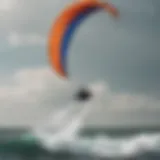Exploring Alias Riding Gear for Kitesurfers
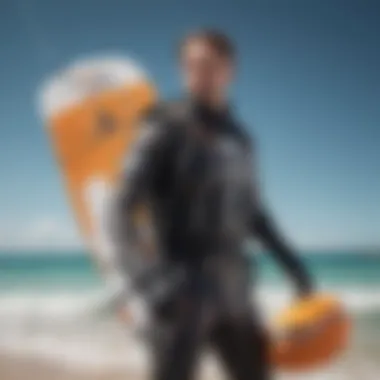

Intro
In the realm of kitesurfing and kiteboarding, the significance of specialized riding gear remains paramount. Alias riding gear plays a crucial role in enhancing performance, safety, and overall enjoyment. This article delves into the intricate details surrounding various aspects of alias riding gear, facilitating informed decisions for both newcomers and seasoned enthusiasts.
Understanding the essential components of riding gear is fundamental. With the constant evolution in technology and materials, kitesurfers and kiteboarders must stay abreast of the latest developments in order to optimize their experiences. By exploring equipment reviews, travel destinations, techniques, tutorials, and safety guidelines, this guide aims to empower enthusiasts to engage with their sport in a more meaningful way.
Equipment Reviews
Kites
Kites are critical for any kitesurfer or kiteboarder. Recent models come with features that can dramatically affect performance and ease of use. Popular brands include North, Duotone, and Cabrinha, known for their innovations and quality.
- Shapes: Kites come in various shapes like delta, bow, and C-shaped. Each shape provides distinct advantages. For instance, delta kites offer ease of use, while C kites excel in performance.
- Sizes: The kite size typically varies from 5 to 17 meters, influencing the wind range capabilities. Bigger kites catch more wind but can be harder to handle in strong conditions.
- Materials: Advanced materials enhance durability and reduce weight. Fabrics like ripstop nylon and polyester are commonly used to improve performance.
Boards
When considering kiteboarding boards, understanding the options is essential. Whether you prefer twintips or directional boards, each type caters to different riding styles.
- Twintip Boards: Ideal for tricks and freestyle, twintip boards offer symmetry, allowing riders to switch directions easily. They often feature foot straps for better control.
- Directional Boards: These are suited for wave riding, providing a unique feel. The design promotes carving and smoother rides in open water.
- Construction: Materials such as fiberglass, carbon fiber, and wood customize flex and performance, tailored to the rider's preferences.
Accessories
Accessories complete the kiting experience, and each piece is vital. Key accessories include harnesses, lines, pumps, and safety gear.
- Harnesses: Necessary for attaching the kite harness to the rider, they come in seat and waist types, catering for different needs.
- Lines: Different thicknesses and materials are available, impacting strength and sensitivity.
- Pumps: Quality pumps enable efficient inflation, ensuring readiness for the water.
- Safety Gear: Impact vests, helmets, and knife tools are crucial for ensuring safety while kitesurfing and kiteboarding.
Travel Destinations
Popular Spots
For kiteboarders and kitesurfers, selecting ideal locations is essential. Locations such as Cape Town, Tarifa, and the Caribbean islands offer remarkable wind and water conditions.
- Cape Town: Known for strong winds and stunning beaches, it attracts many enthusiasts.
- Tarifa: This Spanish destination is famous for its consistent wind and vibrant atmosphere.
- Caribbean Islands: Places like Bonaire and the Bahamas provide perfect conditions for kiting and ample leisure opportunities.
Off the Beaten Path
Exploring less-known venues can yield unique experiences. Locations such as Zanzibar and Brazil's north coast have emerged as hidden gems.
- Zanzibar: Offers idyllic views with steady winds and warm waters.
- North Coast of Brazil: Known for its incredible waves and vibrant culture, it also hosts fewer crowds.
Techniques and Tutorials
Beginner Guides
For beginners, the journey starts with basic techniques, including launching, riding, and landing the kite. Step-by-step tutorials can simplify learning.
- Launching: Ensure the kite is correctly positioned to catch the wind.
- Riding: Balance and using the kite's power are key components.
- Landing: Practicing controlled landings is essential for safety.
Advanced Skills
Once basic skills are mastered, exploring advanced maneuvers opens new possibilities. Techniques like jumps, tricks, and wave riding require dedicated practice.
- Jumps: Learn the mechanics of timing and body positioning for successful execution.
- Freestyle Tricks: Development of style and versatility enhances performance while engaging the audience.
Safety Guidelines
Weather Conditions
Understanding local weather patterns is vital for safety. Wind strength and direction greatly influence kiting conditions. Riders must analyze forecast elements and be prepared for changes.
Emergency Protocols
Safety measures are fundamental. Outlining emergency procedures can save lives. Competent rescue tactics should be understood, enabling swift action in case of mishaps.
Equipment Maintenance
Regular check-ups on gear ensure optimal performance. This includes inspecting lines, kites, and boards for wear and tear. Prioritizing maintenance contributes to prolonged equipment life and heightened rider safety.
Preamble to Alias Riding Gear
Understanding alias riding gear is essential for anyone involved in kitesurfing or kiteboarding. This gear significantly impacts performance, safety, and enjoyment of the sport. Selecting the appropriate equipment can enhance one’s skills, increase durability, and provide optimal comfort. In this section, we will explore why alias riding gear matters and how it can affect an individual’s experience on the water.
Definition and Importance
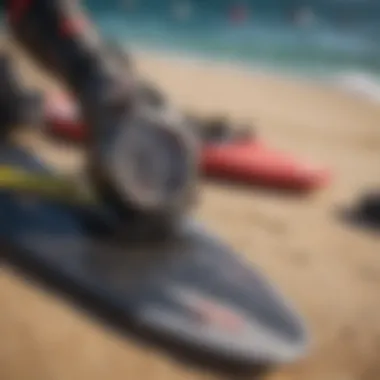

Alias riding gear includes various components such as kites, boards, harnesses, and safety equipment used in kitesurfing and kiteboarding. Each piece serves a specific purpose, contributing to the overall performance and safety of the sport.
Properly fitted kites can ensure that athletes can harness wind power efficiently, while suitable boards enhance maneuverability and stability. Harnesses are crucial for distributing load and providing comfort during rides. Additionally, safety gear is vital for preventing injuries, especially in challenging environments.
When choosing alias riding gear, it is important to consider factors such as skill level, environmental conditions, and personal preferences. Recognizing the significance of each component helps riders make informed decisions, ultimately improving their kitesurfing or kiteboarding experience.
Historical Context
The development of alias riding gear can be traced back to the evolution of kitesurfing in the late 20th century. Initially, the sport relied on simple designs and rudimentary materials. As enthusiasts pushed the boundaries of what was possible, gear began to evolve rapidly.
The introduction of advanced materials like Kevlar and carbon fiber transformed the durability and performance of kites and boards. Designs became more sophisticated, incorporating better aerodynamics and user ergonomics. Over time, technology has significantly influenced the development of safety gear, leading to improved protective equipment.
Today, the kitesurfing industry thrives on innovation, with manufacturers continuously introducing new technologies and designs. By understanding this historical context, kitesurfers and kiteboarders can appreciate the advancements in alias riding gear and make choices that align with their skill levels and aspirations.
Components of Alias Riding Gear
The components of alias riding gear consist of kites, boards, harnesses, and safety gear. Each element plays a crucial role in providing performance, safety, and overall enjoyment for kitesurfers and kiteboarders. Understanding the specifics of these components helps riders make educated choices when selecting equipment suited to their needs and preferences.
Kites
Types of Kites
Kites are core to the kitesurfing experience. There are primarily three types: inflatable kites, foil kites, and sled kites. Inflatable kites are popular for their versatility and ease of use. They tend to handle strong winds well and offer better stability. Foil kites, while less common, provide efficiency in light winds but may be tricky for beginners. Finally, sled kites are a good choice for specific conditions and generally offer high lift. Understanding these types can directly influence performance, giving kitesurfers the tools they need to excel.
Kite Sizes and Shapes
Kite sizes and shapes vary significantly. Size is typically measured in meters and affects both power and control. A larger kite yields more power, making it suitable for lighter winds, whereas smaller kites perform better in high winds. The shape impacts handling. Hybrid shapes, for instance, blend characteristics from different types to cater to diverse riding styles. Selecting the right size and shape optimizes a rider's experience based on their skill level and environmental conditions.
Material Innovations
Advancements in materials have enhanced kites’ durability and performance. Modern kites often use ripstop nylon or polyester, which are both lightweight and remarkably strong. Increased use of eco-friendly materials is also becoming more common, attracting environmentally conscious riders. These innovations lead to improved inflation systems and better aerodynamic properties, enhancing user experience while reducing environmental impact.
Boards
Board Shapes and Sizes
The board is another essential component for a kitesurfer. Boards come in various shapes and sizes, affecting stability, speed, and maneuverability. Common options include directional boards, ideal for surf-style riding, and twin-tips, favored for versatility. Riders need to choose boards suited to their specific style and conditions. Larger boards provide better floatation for beginners while smaller ones are ideal for tricks and speed.
Material Considerations
Material of the board significantly impacts performance and weight. Most boards are made using materials like wood, epoxy, and carbon fiber. Each material has distinct benefits; for instance, carbon fiber boards are very lightweight and responsive but can be pricey. On the other hand, wooden boards offer durability at a lower cost. Understanding these differences can guide riders in selecting the right board based on their budget and performance needs.
Bindings and Foot Straps
Bindings and foot straps ensure a secure connection between the rider and the board. Different styles include strap-in bindings and boot systems. Strap-in options allow for easy adjustments while boot systems offer maximum support and control. Choosing the right binding is crucial for safety and comfort, as it affects how well a rider can execute tricks and navigate varying conditions.
Harnesses
Types of Harnesses
Harnesses come in a few types: waist harnesses and sit harnesses. Waist harnesses are more common among advanced riders, allowing greater mobility, while sit harnesses provide more support for beginners. When choosing a harness, it is important to consider personal comfort and the riding style, as each type has specific characteristics that cater to different preferences.
Fit and Comfort
Proper fit is crucial for harness performance. An ill-fitting harness can lead to discomfort and hinder performance. Most harnesses feature adjustable straps and padding designed for comfort. A good harness should distribute pressure evenly to avoid painful pinching and movement restriction. Testing harness fit is essential for achieving optimal comfort while riding.
Anatomy of a Harness
A harness consists of several key parts: the spreader bar, leg straps, and back support. The spreader bar connects the harness to the kite's lines, while leg straps keep the harness secure. The back panel plays a role in comfort and support, aiding in posture during riding. Understanding the anatomy ensures riders can select a harness that fits well and meets their needs.
Safety Gear
Impact Vests
Impact vests protect the torso from impacts and add buoyancy. They are essential for riders who practice jumps and tricks. A basic vest should fit snugly and not impede movement. Choosing the right thickness and flexibility level in a vest ensures proper protection and comfort during activity.
Helmets
Helmets significantly reduce the risk of head injuries while riding. While some riders may overlook helmets, they are vital for safety, especially in challenging conditions. A helmet should fit securely, and some options come equipped with features like ear protection for colder climates. Prioritizing helmet use is a key practice for safety in the sport.
Leashes
Leashes ensure that the rider remains connected to their equipment. They come in various lengths and designs. A well-chosen leash prevents equipment loss in the water, providing peace of mind for riders. The leash should be durable and flexible enough to allow movement without becoming a hindrance.
Selecting the Right Alias Riding Gear
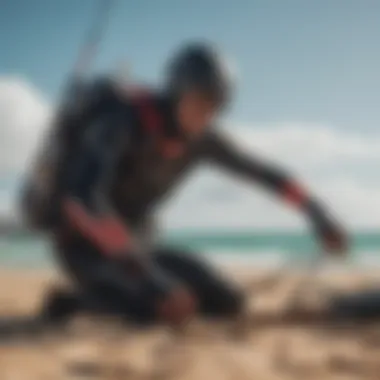

Selecting the right alias riding gear is crucial for any kitesurfer or kiteboarder. The right equipment ensures optimal performance while reducing the risk of injury. Understanding personal skill levels, environmental factors, and budget constraints can all influence the choices available when it comes to gear. This section will explore these aspects in detail, aiding in the selection process for both beginners and experienced riders.
Assessing Your Skill Level
Assessing your skill level is the first step in choosing riding gear. For beginners, it is essential to opt for equipment that facilitates learning. A larger kite with a lower aspect ratio can provide better stability. In contrast, advanced riders might prefer more specialized gear that allows for greater maneuverability and performance.
A rider’s skill dictates not just the type of kite or board, but also the harness choice. If you are just starting out, prioritize comfort and ease of use to boost confidence on the water. Advanced riders might seek high-performance models tailored to specific styles such as freestyle or wave riding.
Environmental Considerations
Environmental factors significantly influence the effectiveness of kitesurfing gear. Three main aspects to consider are wind conditions, water type, and temperature.
Wind Conditions
Wind conditions can dictate your choice of gear on any given day. Light wind situations may require larger kites to catch enough lift, while strong winds mean a smaller, stiffer kite is often preferred.
Choosing the appropriate kite size not only ensures better control but also enhances safety.
A key characteristic of wind conditions is their consistency. Strong, steady winds are generally more favorable for experienced riders as they can better handle the increased power. On the other hand, gusty conditions can be challenging, particularly for beginners who may struggle to manage sudden changes in the wind.
Water Type
The type of water can affect gear selection as well. Flat water conditions tend to be more forgiving, making them an ideal environment for beginners. Riders can easily practice techniques without worrying about waves disrupting their flow. Conversely, ocean settings with waves require boards designed for wave riding to maintain stability and control during stronger currents and waves.
Each type of water can also have its unique challenges. Choppy water might demand a different type of board than flat water, thus affecting your overall experience.
Temperature
Temperature plays a critical role in kitesurfing, impacting both comfort and performance. Warmer water tends to be less constricting, allowing for more freedom of movement. However, cooler temperatures necessitate thicker wetsuits or drysuits, which can feel bulky and limit flexibility.
The key characteristic of temperature is its variability. Different areas can have fluctuations in temperature throughout the year. Riders must adapt their gear based on local weather patterns and personal comfort preferences. Choosing the right wetsuit thickness or type is essential so it does not hinder performance but still offers protection against the elements.
Budget Constraints
Budget constraints can heavily influence your choice of alias riding gear. It is key to strike a balance between quality and affordability. Opting for the most expensive gear is not always necessary, particularly for newcomers who may not commit long-term to the sport. However, investing in a few essential items can significantly enhance your experience.
In summary, carefully selecting the right alias riding gear involves assessing personal skills, considering environmental factors, and remaining mindful of budget limitations. Each of these elements contributes valuable insights into making informed decisions, ultimately leading to a more enjoyable riding experience.
Caring for Your Alias Riding Gear
Caring for your alias riding gear is essential for both performance and longevity. Proper maintenance not only enhances the functionality of your equipment but also contributes to your safety during kitesurfing or kiteboarding sessions. The wear and tear that comes with regular use can affect your gear's performance, leading to potential hazards on the water. Therefore, understanding effective cleaning techniques, storage recommendations, and the importance of routine inspections is crucial for any enthusiast.
Proper Cleaning Techniques
Keeping your equipment clean is paramount. After every session, it is advisable to rinse your kites, boards, harnesses, and other accessories with fresh water to remove salt, sand, and any debris. Salt and sand can degrade materials over time, causing wear and leading to malfunctions. A gentle wash with mild soap may be required for stubborn grime. Here are some key points for cleaning:
- Rinse Thoroughly: Use fresh water immediately after use.
- Avoid Harsh Chemicals: Stick to mild, environmentally-safe soaps to prevent damage.
- Dry Properly: Allow the gear to air dry completely before packing it away. This helps prevent mold and corrosion.
Storage Recommendations
Storing your alias riding gear correctly is just as critical as cleaning it. Improper storage can lead to structural damages and shorten the lifespan of your items. Ideally, gear should be stored in a cool, dry place out of direct sunlight. Here are some storage best practices:
- Keep Away from Sunlight: Excessive sun exposure can fade colors and weaken materials.
- Organize Gear: Store kites and boards upright in padded bags to avoid scratches and dents.
- Ventilation: Ensure your gear has ample airflow while stored to reduce moisture accumulation.
Routine Inspections
Periodic inspections of your gear play a vital role in ensuring safety and performance. Regular checks can help spot wear and tear before they lead to accidents. Here are the aspects to focus on during inspections:
- Kite Inspection: Check for any tears or holes, especially along seams.
- Board Check: Look for scratches or delamination that could affect performance.
- Harness and Safety Gear: Ensure buckles and straps are secure and not frayed.
"Investing time in caring for your gear ensures not just longevity, but also enhances your safety and performance on the water."
By implementing these care strategies, you can ensure your alias riding gear remains in peak condition, ready for your next adventure on the water.
Common Misconceptions About Alias Riding Gear
Understanding alias riding gear involves clarifying several misconceptions that may hinder informed decision-making. This section addresses common myths and misunderstandings surrounding alias riding gear. Highlighting the inaccuracies can significantly influence how kitesurfers and kiteboarders perceive the importance of cost, quality, and gear longevity.
Cost vs. Quality
One prevalent misconception is that a higher price always equates to higher quality. While it is true that many premium products come with advanced features, it is essential to evaluate whether those features are necessary for one's riding style and environment. In some cases, lower-cost options can perform exceptionally well without the frills that might add to the price tag.
Factors influencing the price of alias riding gear usually include:
- Brand reputation
- Material quality
- Technological innovations
- Warranty and customer support
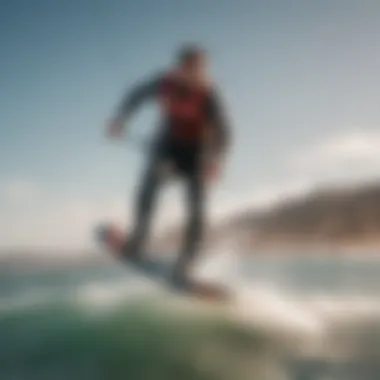

A thorough inspection of the specifications and user reviews can shed light on whether a product offers genuine value. Therefore, focusing more on performance and durability rather than the sticker price is vital.
Newer is Always Better
Another misconception is the belief that newer equipment automatically leads to better performance. While innovation is crucial in the industry, previous models often have features that can still meet a rider's needs effectively.
The persistent updates in gear technology can sometimes create pressure to upgrade when it is not necessary. Familiarity with specific equipment allows riders to optimize their performance and comfort.
In essence, riders should ask themselves the following questions:
- Is the newer model significantly different in performance?
- Will I benefit from the advancements personally?
- What do experienced riders say about the older generation gear?
The takeaway is that both old and new gear can play crucial roles in a successful riding experience. Focus on personal comfort and performance rather than solely on the latest model availability.
Innovative Trends in Alias Riding Gear
The world of kitesurfing and kiteboarding is not static; it continually evolves, adapting to new technologies and changing consumer preferences. As such, understanding innovative trends in alias riding gear is crucial for both enthusiasts and serious athletes. These trends are not just about aesthetics; they often enhance performance, safety, and user experience. This section dives into two significant areas: technological advances and customization options. Each innovation presents both opportunities and challenges, impacting how gear is developed and perceived.
Technological Advances
Smart Gear
Smart gear represents a fascinating leap forward in riding equipment. It typically incorporates high-tech features such as sensors, GPS tracking, and connectivity to smartphones. The primary benefit of smart gear is its capability to provide real-time data, such as speed, distance traveled, and even wind conditions. This data allows riders to make informed decisions while they are on the water.
One notable characteristic of smart gear is its ability to collect performance metrics that users can analyze later. Riders can review their statistics post-session to identify areas for improvement. However, these advancements come with considerations. The reliance on technology can be a double-edged sword; while it enhances user experience, it may offer distractions, especially for less experienced riders. Furthermore, the durability and waterproofing of these gadgets are crucial in preventing damage during use.
"Smart gear brings a new level of data-driven performance to kitesurfers and kiteboarders, but it also requires careful handling and maintenance."
Eco-Friendly Materials
Eco-friendly materials have gained traction in the kitesurfing and kiteboarding industry. These materials often include recycled plastics, organics, or other sustainable resources aimed at reducing environmental impact. A key feature of eco-friendly materials is their ability to maintain high performance standards while being more responsible in terms of ecological footprint.
Choosing eco-friendly materials is not just about being trendy or ethical; it reflects growing consumer awareness about environmental issues. These materials often have a unique selling point—products made from eco-friendly materials are frequently marketed as durable and long-lasting, challenging the notion that sustainable items compromise on quality. However, the switch to eco-friendly options can also lead to increased costs in production, which may impact the final price for consumers, making it an important consideration for budget-conscious riders.
Customization Options
Customization options have changed how kitesurfers and kiteboarders choose their gear. Riders can now personalize their equipment as per their preferences and performance needs. This growing trend caters not only to aesthetics but also to functionality, making gear more user-friendly and performance-oriented.
Personalized Designs
Personalized designs allow athletes to express their individuality on the water. This could range from specific graphics to color schemes tailored to a rider's personal style. The unique characteristic of personalized designs is that they can also reflect local culture, trends, or personal stories, offering a deeper connection to the gear.
Despite their appeal, personalized designs can sometimes lead to longer wait times for production. Additionally, custom options might come with higher costs, which requires riders to evaluate their budget against their desire for uniqueness. Still, for many, the joy of having custom gear outweighs any potential downsides.
Adjustable Features
Adjustable features in riding gear provide a significant advantage. This might include adjustable straps, harnesses, or the ability to tweak the flex of a board. Such flexibility enhances comfort and performance, ensuring riders can fine-tune equipment to suit their specific riding style.
The key characteristic of adjustable features is their ability to accommodate various body types and riding conditions, making them more versatile. However, it is essential to note that while they offer increased comfort, they can also complicate the selection process for less experienced riders who might not yet know what adjustments they prefer. Therefore, proper education about how to utilize these features effectively is essential.
In summary, the incorporation of innovative trends in alias riding gear enhances the riding experience for kitesurfers and kiteboarders. Smart gear transforms how data is utilized on the water, while eco-friendly materials reflect a commitment to sustainability. Customization, through personalized designs and adjustable features, caters to individual needs and preferences, ensuring that each rider can find gear that truly resonates with them.
Culmination
In the context of this article, the conclusion serves as a vital synthesis of all the topics discussed related to alias riding gear for kitesurfers and kiteboarders. It is not just a summary; rather, it provides a reflective lens through which to view the entire journey of understanding gear selection and maintenance.
The significance of alias riding gear lies in its ability to greatly enhance the riding experience. By focusing on the right components, such as kites, boards, harnesses, and safety equipment, individuals can ensure they are well-protected and capable of maximizing performance on the water. Knowledge about care and maintenance is equally important. A good understanding of how to clean and store gear can extend its lifespan, thereby making informed decisions more economically viable.
Furthermore, addressing common misconceptions helps to demystify the various elements associated with gear. Enthusiasts often operate under fixed beliefs about cost or the necessity of constant upgrades. This article encourages informed thinking, guiding readers to evaluate products critically rather than following trends blindly.
Lastly, the prospect of future innovations in alias riding gear is indeed exciting. Like many sports, kitesurfing and kiteboarding constantly evolve through technology and material advancements. The focus on eco-friendly alternatives and smart gear is just an example of how this sport aligns with global trends.
Overall, grasping the importance of alias riding gear not only prepares individuals for better performance but also contributes to their overall safety and enjoyment on the water.
Recap of Key Points
- Components of Gear: Understanding kites, boards, harnesses, and safety gear is fundamental to kitesurfing and kiteboarding.
- Selecting Gear: Factors such as skill level, environmental conditions, and budget should guide your selections.
- Maintenance: Proper cleaning, storage, and routine inspections prolong the life of gear and enhance performance.
- Misconceptions: Cost is not always an indicator of quality, and newer gear might not always be the best choice.
- Future Trends: Expect to see innovations in smart gear and eco-friendly materials shaping the kitesurfing landscape.
The Future of Alias Riding Gear
Looking ahead, the future of alias riding gear is poised for significant transformation. Technological advances promise to revolutionize the way equipment performs. Smart gear will be one area to watch closely. Features that monitor performance metrics or track environmental conditions can make a rider's experience more interactive. This level of data can also enhance safety by allowing for real-time feedback.
Additionally, the trend toward sustainability is growing. Kitesurfers and kiteboarders are becoming more conscious of their environmental impact. Brands emphasizing eco-friendly materials will likely attract more enthusiasts, prompting broader shifts in the market.
Customization options are also on the rise. Riders appreciate gear that can be tailored to fit their unique preferences, be it in design or functionality. This trend not only enhances personal expression but improves comfort and overall performance.
Overall, the fusion of technology, sustainability, and customization indicates that the future holds promising developments for alias riding gear. These advancements will not only improve functionality but also resonate with the values of the kitesurfing community.
"The evolution of gear is a reflection of the sport itself; as we advance through technology and awareness, we elevate our practice and community."
The landscape of kitesurfing and kiteboarding will surely continue to evolve as new innovations and ideas emerge, fundamentally impacting how enthusiasts approach their sport.
